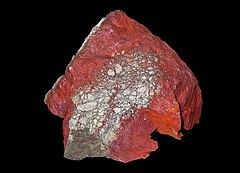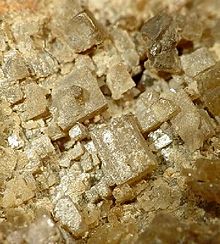Table of Contents
If heated in a glass tube together with carbonate of soda, mercury compounds yield a sublimate of mercury on the cold part of the tube.
Native Mercury
Is sometimes found as fluid globules of a tin-white colour. S.G-.—13·6. Is volatile before the B.F., and easily dissolves in nitric acid.
Cinnabar (sulphide of mercury)
This is the ore from which commercial mercury is obtained. Sometimes found massive, with a granular structure, sometimes in a crystallized form, the crystals being brilliant, transparent, and of a beautiful carmine colour.
- Colour—generally red, sometimes bright red; also brown, brownish black, &c.
- Streak—red.
- Lustre—unmetallic.
- Structure—sectile.
- H.—2 to 2·5 ; S.G.—6 to 8.
- Contains 86 per cent, of mercury, the rest sulphur.
Is volatile before the B.F. Soluble in aqua regia (4 hydrochloric acid and 1 nitric acid), but not in either hydrochloric or nitric acid. A piece of clean copper placed in the solution will be coated with a film of mercury.
If the powdered ore be placed together with quicklime in an iron pan and gently heated, a globule of mercury will be found at the bottom of the pan.
If the powdered ore be placed in a glass vessel capable of standing heat, such as a thin oil flash, and exposed to a strong flame, the mercury will form a sublimate on the upper and cool part of the vessel.
If heated in a tube closed at one end, globules of mercury condense on the cool portion. Near the test piece a black (red on being rubbed) sublimate is formed.
By placing powdered ore in the mouth of a tobacco-pipe, closing the mouth with clay, and exposing the bowl to a fair heat, the mercury may be collected on a cool surface, held so that the fumes given off may be condensed.
A gold coin or a piece of clean copper placed in the fumes will soon have a deposit of mercury on its surface.
Chloride of Mercury (horn quicksilver)
Is crystalline and granular, of a dirty white or ash grey colour, and a yellowish streak. Frequently associated with cinnabar.
H.—1 to 2 ; S.G.—6·48.
Selinide of Mercury
Of a steel or lead grey colour and metallic lustre; occurs in Mexico.
The following are some of the places where cinnabar is found and its mode of occurrence :—
California—As deposits in cretaceous rocks, &c.
Idria in Illyria—Disseminated through bituminous schist, limestone, or grit.
Spain—In veins traversing a micaceous schist.
Australia—In veins through Devonian rocks, &c.
Italy—In small veins through mica slate.
Mexico—There is a mercury-producing vein in pitchstone porphyry.
South America—There is a mercury-bearing ore in strata of shales and sandstones. In Utah is found associated with gold.
Generally speaking, mercury ores occur in both early and late geological formations. In New South Wales small rounded pieces of cinnabar have been found in a gold and gem-bearing alluvial.
